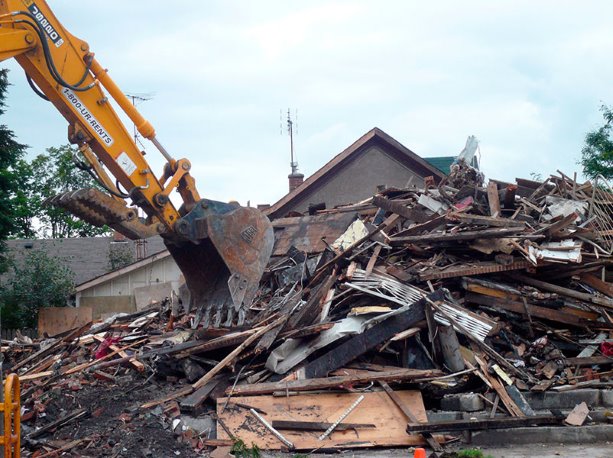Starting Jan. 1 Ontario’s cap and trade legislation takes effect but its impact on the construction and demolition industry is still muddy.
There is going to be an impact on waste streams over the next 12 to 18 months, state industry experts.
While individual construction trades and sectors may not initially be required to pay based on their CO2 emissions, they will be hit with higher fuel surcharges, while other regulatory changes are in motion to limit the amount of waste sent to landfill.
Under the new cap and trade system, companies must prepare and submit a report if they emit 10,000 tonnes or more of greenhouse gases emissions (GHGs) in a year or operate a facility generating more than 25,000 tonnes of GHGs per year.
It’s a massive headache looming on the horizon because it is so complex and so fragmented at this early stage, says Renee Gratton, president and CEO of the Construction Resource Initiatives Council based in Ottawa.
She said the construction and demolition sectors will have to grapple with both cap and trade and new legislation, the Waste-Free Ontario Act, which will set limits on what goes to landfill, including construction waste.
Bill 151 was passed June 1 and will transform Waste Diversion Ontario into a new agency, the Resource Productivity and Recovery Authority, with the power to enforce compliance, obtain search warrants and seize documents and materials.
It ultimately seeks to divert all waste streams from landfills, phasing out existing programs for electronics and tire recycling and folding them all in to one program.
Part of that stream being diverted from landfill includes construction, renovation and demolition waste.
Details on how and when this will impact the construction and demolition sectors, however, remain unknown, says Peter Hargreave, acting CEO of the Ontario Waste Management Association (OWMA).
A report looking at the impact of cap and trade on waste management for the OWMA, tabled in spring 2016, noted construction, renovation and demolition waste includes brick, painted wood, drywall, metal, carpet, cardboard, doors, windows, wiring and other materials.
However, Hargreave notes, most commercial construction and demolition waste is already separated because there is a value in recycling. Metals are re-smelted and aggregates and asphalt are reused.
Still, Ontario produces about 14.2 million tonnes of construction, renovation and demolition waste which represents about 2 million tonnes of CO2. Only about 300,000 tonnes of CO2 is captured by current regulation or practice, the report stated, leaving a potential 1.7 million tonnes of CO2 to be mitigated. Wood, carpet and underlay waste top the list in terms of emission intensity ratings.
According to most recent figures, in 2013 about 22 per cent of all garbage is created by the construction, renovation and demolition sector with about 12 per cent diverted, leaving 88 per cent heading to landfill.
While some projects have recycled or reused up to 95 per cent of materials taken from demolition of ICI structures, there is a lot of room for improvement, the report notes.
It identified opportunities around GHG emissions when it comes to recycling and reusing materials generally.
He said more than 20 million tonnes of CO2 could come just from better recycling and reuse — about two million from construction, renovation and demolition waste.
The OWMA report notes cap and trade won’t do much to change patterns by itself which is why waste reduction proponents are looking to the Waste-Free Ontario Act and the new agency.
The report suggested more can be done to divert waste into what’s called the "Circular Economy," which is one of the driving forces of the Waste-Free Ontario Act.
The Circular Economy, which is getting a lot of attention in Europe, is a move away from the Linear Economy in which we make, buy, use or consume goods and then dispose of them. The Circular Economy seeks to reuse, recycle all products, materials and organics either to remake similar products and materials or to convert them into new products and materials.
Construction wood waste, for example, will have to be separated on site much like metals and masonry debris are now. It will then be shipped to businesses that process it into new products, such as chips to make MDF or garden mulch material or sawdust to make wood fuel pellets or animal bedding. Carpet can also be recycled back into its original chemical components.
Scrap drywall would also be separated and sent for processing for the gypsum to be recovered and reused either to make drywall again, to make cement, as a soil treatment, fertilizer or composting additive.
What’s needed, said Hargreave, is more data to get a handle on what is really going on in the waste stream and to look at what mechanisms can be put in place to divert waste from landfill and back into the manufacturing process.
Proponents of energy-from-waste and the use of construction, renovation and demolition waste to fire cement kilns are missing the point, says Gratton.
"There’s still a carbon footprint there," she said, adding those in the construction and demolition sector should start to join in the discussion. "There needs to be an integrated approach with government and all stakeholders."
She said an upcoming conference in Montebello next May is part of that dialogue which needs to happen before the process dissolves into government directives and enforcement and pushback.
The Ontario Association of Demolition Contractors said it wasn’t aware of the OWMA report or of any impact cap and trade would have yet.
The construction and demolition sector will likely find landfill fees start to rise to punitive levels as the new agency wields its stick.
The carrot may be credits or offsets for that waste which is diverted to recycling.
"The carbon cap and trade system we have now, however, doesn’t have any way of acknowledging reductions so there’s no incentive to manufacturers for using glass pellets or scrap steel or used tires or plastics," said Hargreave.
"There’s no credit and in some cases there are competitive disadvantages."
Where the cap and trade system could play a role is benchmarking products and differentiating those that are made from reclaimed materials from those made from raw materials as well as figuring in emissions related to transportation to give locally made products an edge over imports.
"There will be a direct impact on the construction and demolition sector in terms of energy," he says, acknowledging dump trucks and front-end loaders don’t come in electric-powered models.
"They will have to look at whether they can reduce distances and their fleets and see if they can find efficiencies there, though the initial dollar impact won’t be huge."











Recent Comments
comments for this post are closed